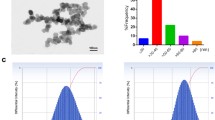Abstract
In this study, the differentially expressed proteins by titanium dioxide nanoparticles (TiO2 NPs) in mouse lung were examined via proteomic approach to better understand the molecular mechanism by which TiO2 NPs could induce toxicities at the protein level. We identified eight proteins that exhibited more than two-fold changes in expression by TiO2 NPs. Of these, five proteins, named cytoplasmic aconitase, L-lactate dehydrogenase A chain, carbonic anhydrase 1, pyruvate kinase isoform M2 and peroxiredoxin 6 displayed increased intensities in TiO2 NP-exposed lungs, while three proteins, named heat shock protein, moesin and apolipoprotein A-1 precursor, showed reduced intensities.
Similar content being viewed by others
References
Park, E. J., Yoon, J., Choi, K., Yi, J. & Park, K. S. Induction of chronic inflammation in mice treated with titanium dioxide nanoparticles by intratracheal instillation. Toxicology 260:37–46 (2009).
Gurr, J. R., Wang, A. S., Chen, C. H. & Jan, K. Y. Ultrafine titanium dioxide particles in the absence of photoactivation can induce oxidative damage to human bronchial epithelial cells. Toxicology 213:66–73 (2005).
Kim, Y. J. et al. Genotoxicity of aluminum oxide (Al2O3) nanoparticle in mammalian cell lines. Mol Cell Toxicol 5:172–178 (2009).
Chen, H. W. et al. Titanium dioxide nanoparticles induce emphysema-like lung injury in mice. FASEB J 20:2393–2395 (2006).
Wang, J. et al. Acute toxicity and biodistribution of different sized titanium dioxide particles in mice after oral administration. Toxicol Lett 168:176–185 (2007).
Xu, J. et al. Involvement of macrophage inflammatory protein 1alpha (MIP 1 alpha) in promotion of rat lung and mammary carcinogenic activity of nanoscale titanium dioxide particles administered by intra-pulmonary spraying. Carcinogenesis 31:927–935 (2010).
Linnainmaa, K., Kivipensas, P. & Vainio, H. Toxicity and cytogenetic studies of ultrafine titanium dioxide in cultured rat liver epithelial cells. Toxicol In Vitro 11:329–335 (1997).
Sohaebuddin, S. K., Thevenot, P. T., Baker, D., Eaton, J. W. & Tang, L. Nanomaterial cytotoxicity is composition, size, and cell type dependent. Part Fibre Toxicol 7:22 (2010).
Scown, T. M. et al. High doses of intravenously administered titanium dioxide nanoparticles accumulate in the kidneys of rainbow trout but with no observable impairment of renal function. Toxicol Sci 109:372–380 (2009).
Qin, G., Meng, X., Wang, Q. & Tian, S. Oxidative damage of mitochondrial proteins contributes to fruit senescence: a redox proteomics analysis. J Proteome Res 8:2449–2462 (2009).
DeSouza, L. V. et al. Multiple reaction monitoring of mTRAQ-labeled peptides enables absolute quantification of endogenous levels of a potential cancer marker in cancerous and normal endometrial tissues. J Proteome Res 7:3525–3534 (2008).
Christofk, H. R., Vander Heiden, M. G., Wu, N., Asara, J. M. & Cantley, L. C. Pyruvate kinase M2 is a phosphotyrosine-binding protein. Nature 452:181–186 (2008).
Schneider, J., Morr, H., Velcovsky, H. G., Weisse, G. & Eigenbrodt, E. Quantitative detection of tumor M2-pyruvate kinase in plasma of patients with lung cancer in comparison to other lung diseases. Cancer Detect Prev 24:531–535 (2000).
Suh, S. Y. & Ahn, H. Y. Lactate dehydrogenase as a prognostic factor for survival time of terminally ill cancer patients: a preliminary study. Eur J Cancer 43:1051–1059 (2007).
Wang, Y., Feinstein, S. I. & Fisher, A. B. Peroxiredoxin 6 as an antioxidant enzyme: protection of lung alveolar epithelial type II cells from H2O2-induced oxidative stress. J Cell Biochem 104:1274–1285 (2008).
Badger, M. R. & Price, G. D. The role of carbonic anhydrase in photosynthesis. Ann Rev Plant Physiol Plant Mol Biol 45:369–392 (1994).
Radhakrishnan, R. & Sluka, K. A. Acetazolamide, a carbonic anhydrase inhibitor, reverses inflammationinduced thermal hyperalgesia in rats. J Pharmacol Exp Ther 313:921–927 (2005).
Vuilleumier, N. et al. Presence of autoantibodies to apolipoprotein A-1 in patients with acute coronary syndrome further links autoimmunity to cardiovascular disease. J Autoimmun 23:353–360 (2004).
Hyka, N. et al. Apolipoprotein A-1 inhibits the production of interleukin-1beta and tumor necrosis factoralpha by blocking contact-mediated activation of monocytes by T lymphocytes. Blood 97:2381–2389 (2001).
Charafe-Jauffret, E. et al. Moesin expression is a marker of basal breast carcinomas. Int J Cancer 121:1779–1785 (2007).
Blackford, J. A. Jr., Jones, W., Dey, R. D. & Castranova, V. Comparison of inducible nitric oxide synthase gene expression and lung inflammation following intratracheal instillation of silica, coal, carbonyl iron, or titanium dioxide in rats. J Toxicol Environ Health 51:203–218 (1997).
Taiyab, A., Sreedhar, A. S. & Rao, Ch. M. Hsp90 inhibitors, GA and 17AAG, lead to ER stress-induced apoptosis in rat histiocytoma. Biochem Pharmacol 78:142–152 (2009).
Liu, S., Xu, L., Zhang, T., Ren, G. & Yang, Z. Oxidative stress and apoptosis induced by nanosized titanium dioxide in PC12 cells. Toxicology 267:172–177 (2010).
Park, S. K., Nam, S. W. & Lee, M. Y. Ethylbenzeneinduced differential protein profiles in rat liver. BioChip J 4:272–278 (2010).
Jeon, Y. M., Park, S. K., Rhee, S. K. & Lee, M. Y. Proteomic profiling of the differentially expressed proteins by TiO2 nanoparticles in mouse kidney. Mol Cell Toxicol 6:419–425 (2010).
Park, S. K., Jeon, Y. M., Son, B. S., Youn, H. S. & Lee, M. Y. Proteomic analysis of the differentially expressed proteins by airborne nanoparticles. J Appl Toxicol 31:463–470 (2011).
Lee, S. E. et al. Systemic immunity of obese-diabetes model (db/db) mice. Mol Cell Toxicol 6:143–149 (2010).
Al-Banna, N. A., Junaid, T. A., Mathew, T. C., Raghupathy, R. & Albert, M. J. Histopathological and ultrastructural studies of a mouse lung model of Campylobacter jejuni infection. J Med Microbiol 57:210–217 (2008).
Author information
Authors and Affiliations
Corresponding author
Rights and permissions
About this article
Cite this article
Jeon, YM., Park, SK., Kim, WJ. et al. The effects of TiO2 nanoparticles on the protein expression in mouse lung. Mol. Cell. Toxicol. 7, 283–289 (2011). https://doi.org/10.1007/s13273-011-0034-9
Received:
Accepted:
Published:
Issue Date:
DOI: https://doi.org/10.1007/s13273-011-0034-9




